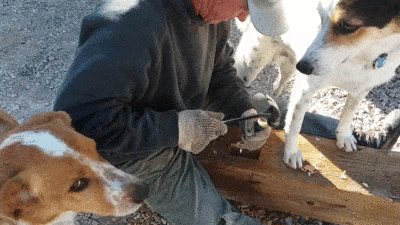
by Linda Halley, General Manager | For eighteen months, a shady hillside along Bryn Drive has been bare. A lone silo remains, a testament to the fact that a dairy barn once stood there. In the next few weeks the barn will rise again, thanks to a couple of unassuming brothers, Tad and Craig Van Valin. The pair disassembled the Ed Williams barn last spring with the promise that they could tinker-toy it back together once a new foundation was in place. Hallelujah! The time has come.
 They have been getting reacquainted with each timber and brace through the process of getting ready to lift the heavy sections back in place. All the framing must be sorted, washed, fitted and, in some cases, re-notched and trimmed. By the time the crane arrives, they will have a precise mental image of just what the barn will look like, and where and how each member fits to the next.
They have been getting reacquainted with each timber and brace through the process of getting ready to lift the heavy sections back in place. All the framing must be sorted, washed, fitted and, in some cases, re-notched and trimmed. By the time the crane arrives, they will have a precise mental image of just what the barn will look like, and where and how each member fits to the next.
They have done this so many times, Tad counts nearly 500 buildings under his belt, that they can read the story each barn tells. Hand hewn beams show the prominent and deep cuts of an adze. Some members are replacements, wedged in where a broken original once stood. The Ed Williams barn includes an interesting mix of sawn and hewn timbers of more than one species. Likely some beams came from the farm, but the largest timbers are white pine from northern Wisconsin.
An experienced eye can estimate the age of a structure, as well as the ethnicity of the builders. Tad pegs this barn’s age at about 140 years, circa 1880. While many immigrant, ethnic groups brought their craftsmanship with them, the Welsh settlers who homesteaded here did not have a timber frame tradition. They may have been responsible for the stone work of the foundation, while hiring out the upper story construction.
The brothers call what they do ethnic architecture. In their small way they hope to have a positive impact on the landscape of southeastern Wisconsin by keeping the historic, rural buildings from disappearing. Driving the back roads of Waukesha County will reveal the truth that few barns are still standing and, of those that are, many are idle. Even where farms remain, the old red barn is often not large enough or tall enough to house modern equipment or designed to house new round bales moved and stacked with skid loaders. Barns were designed and built as utilitarian structures. Without use, it is hard to imagine many will remain. There are organizations around the country with the mission of saving as many as possible. http://www.latimes.com/nation/la-na-hometown-barns-preservation-20141026-story.html
Instead of demolition, Ed’s barn will have a new life and a new purpose. There will be no dairy cows below nor hay above. Instead, our farm offices will occupy a loft level and the CSA vegetable distribution will move to the mow space. Storage, and a staff break room, will be located on the lower, walk-out level. The Ed Williams barn will be with us for another century. Cheers to the craftsmen, Tad and Craig, and everyone else who made it possible.
Linda Halley has been an organic farmer since 1992.
If you would like to read more about Wisconsin barns, I recommend Barns of Wisconsin, by Jerry Apps.
